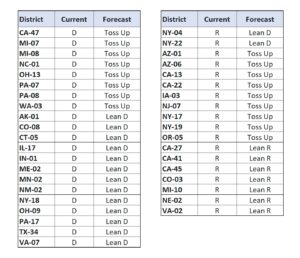While predictive analysis is fun, prescriptive analysis is more useful. To that end, I again focused on identifying which races might be the most important to a Democratic effort to retake the House.
As before, I first identified the House races that were even worthy of further analysis. That pass eliminated those seats that are safely Democratic or Republican in 2024. I next ignored those races that are likely to be won by whoever wins either the Democratic or Republican nomination. While a few of these races could turn out to be important, limited resources should be directed toward those races in swing districts that appear to be somewhat close.
At the moment, that leaves only 39 races of interest for the 435 House seats. Of the rest, my analysis is not particularly good news for Democrats. Republicans are likely to win 203 seats; Democrats are likely to win 193 seats. In the 39 interesting races, Democrats are also defending more seats than Republicans and thus have a steeper climb than Republicans to a 218-seat House majority.
Democrats were not helped by a number of factors:
- 2024 Congressional redistricting efforts did not generally favor Democrats.
- Democratic retirements significantly hurt the chances of holding several current D seats.
On the other hand, things are not all doom and gloom for Democrats:
- The current 118th Congress has been one of the least productive in history. In 2023, Congress managed to pass only 34 bills into law, the lowest number in decades. Republicans controlled the House and thus shoulder that blame. Democrats need to constantly remind voters that their Republican representatives were incredibly incompetent at their jobs.
- The OG lost to Biden in 2020 in 14 of the 18 districts where the Republican candidate won the 2020 House race! Democrats need to coat those 2024 Republicans with bright orange paint.
- The Orange Guy is raiding the coffers of the RNC to pay his legal bills at the expense of down-ballot races, including House races. In close contests, party money could easily make a difference.
- Since party primaries are still in-progress, many of the candidates are not yet set in stone for these races. I’ll update things when I can discuss actual people. At the moment, though, the candidate quality factor looks like it will favor Democrats by a fairly wide margin. While admittedly subjective, the Democrats in many of the close races have impressive resumes – doctors, teachers, military veterans, etc. Others have long, well-respected histories of working across the aisle in their respective state legislatures. The Republican field, however, looks to once again be dominated by MAGA extremists whose primary qualifications are fealty to the OG, insistence that the 2020 election was stolen, an aversion to compromise, and a dedication to conspiracy theories and fear-mongering. While that resume might motivate the GOP base, close races are mostly won in the center.
Here’s my current take on the 39 races: The strategy is straight-forward:
The strategy is straight-forward:
- Democrats first need to defend the 21 seats above that they currently hold. That’s not an easy task since 8 of them are currently Toss Ups. Win all of these, and Democrats would have 214 seats – which is still not a majority.
- Democrats next need to flip the 11 Republican seats that are currently forecast as Lean D or Toss Up. Win all of these, and Democrats would have a 225-seat majority – a workable margin.
- Democrats finally need to target at least a few of the 7 Republican seats that are currently forecast as Lean R – both to allow for some losses above and to make Republicans spend money defending their seats.
So what can we do now? As the candidates come more into focus, I’ll try to post some individual campaign donation links. In the meantime, I’ll suggest two DCCC programs that might be worthy of consideration for some hard-earned cash:
- DCCC Frontline: This program distributes money to current Democratic members of Congress that the DCCC deem to be in competitive 2024 races. Frontline has identified 29 members while I identified 21. I think they missed a couple of close races and they’re throwing money at several races that likely don’t need the help. Still, Frontline’s overlap with my list is significant and I have no problem recommending this program for a one-stop donation to help hold the line.
- DCCC Red to Blue: This program distributes money to Democratic candidates that the DCCC deem to have a decent chance of flipping a Republican-held seat. Red to Blue has identified 20 races while I identified 18. Again, I think they missed a couple of close races and I think they’re throwing money at a few lost causes. While Red to Blue’s overlap with my list isn’t quite as large as Frontline, it’s still a decent set for a one-stop donation to help grow a Democratic majority.